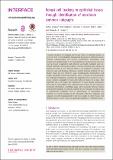Robust cell tracking in epithelial tissues through identification of maximum common subgraphs
Abstract
Tracking of cells in live-imaging microscopy videos of epithelial sheets is a powerful tool for investigating fundamental processes in embryonic development. Characterizing cell growth, proliferation, intercalation and apoptosis in epithelia helps us to understand how morphogenetic processes such as tissue invagination and extension are locally regulated and controlled. Accurate cell tracking requires correctly resolving cells entering or leaving the field of view between frames, cell neighbour exchanges, cell removals and cell divisions. However, current tracking methods for epithelial sheets are not robust to large morphogenetic deformations and require significant manual interventions. Here, we present a novel algorithm for epithelial cell tracking, exploiting the graph-theoretic concept of a 'maximum common subgraph' to track cells between frames of a video. Our algorithm does not require the adjustment of tissue-specific parameters, and scales in sub-quadratic time with tissue size. It does not rely on precise positional information, permitting large cell movements between frames and enabling tracking in datasets acquired at low temporal resolution due to experimental constraints such as phototoxicity. To demonstrate the method, we perform tracking on the Drosophila embryonic epidermis and compare cell-cell rearrangements to previous studies in other tissues. Our implementation is open source and generally applicable to epithelial tissues.
Citation
Kursawe , J , Bardenet , R , Zartman , J J , Baker , R E & Fletcher , A G 2016 , ' Robust cell tracking in epithelial tissues through identification of maximum common subgraphs ' , Journal of the Royal Society Interface , vol. 13 , no. 124 , 20160725 . https://doi.org/10.1098/rsif.2016.0725
Publication
Journal of the Royal Society Interface
Status
Peer reviewed
ISSN
1742-5689Type
Journal article
Collections
Items in the St Andrews Research Repository are protected by copyright, with all rights reserved, unless otherwise indicated.

